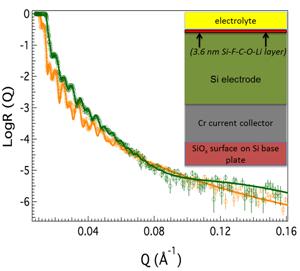
Neutron reflectometry (NR) data collected in air (orange) and in the electrolyte (green) 1.2M LiPF6 - Ethylene carbonate:dimethyl carbonate along with fits to this data (solid lines). Inset shows a graphical representation of electrode architecture (silicon substrate, chromium current collector, silicon anode) and the 3.6 nm reaction layer measured in these experiments. The data shows that the LiPF6 battery salt in the electrolyte reacts with the silicon anode surface forming the Si-O-F reaction layer resulting in a reduction in anode capacity and forming an insulating barrier which increases overvoltages. Controlling the extent of reaction will maintain high capacities and improve cell efficiency.
Neutron reflectometry at the Spallation Neutron Source has revealed the composition and growth characteristics of the spontaneous chemical reaction layer formed between a silicon battery anode and an organic electrolyte that ultimately limits the capacity of the battery. We determined that a 3.6 nanometer reaction layer composed of material dominated by silicon-fluorine bonds forms on the anode material. This insight allows us to understand the loss of capacity (ability to store charge) reported for Si anodes and will direct the search for new Si surface chemistries to mitigate this reaction. Si anodes have nearly 8 times the capacity of standard graphite anodes, giving them high potential for use in electric vehicles batteries with longer ranges and lifetimes. However, the Si anodes require much smaller particle sizes to facilitate diffusion and, due to the higher surface area of these smaller Si particles, interfacial reactions become a more significant source of electrolyte consumption, reducing both the capacity and cycle life of the batteries. The ability to control these reactions is critical for maintaining battery capacity required for a practical silicon-based battery.
Gabriel M. Veith, Loïc Baggetto, Robert L. Sacci, Raymond R. Unocic, Wyatt E. Tenhaeff, and James F. Browning, “Direct measurement of the chemical reactivity of silicon electrodes with LiPF6-based battery electrolytes,” Chemical Communications, 2014 – DOI:10.1039/C3CC49269A
For more information

